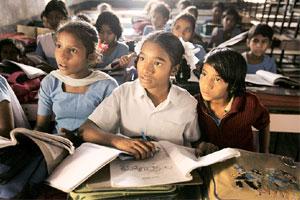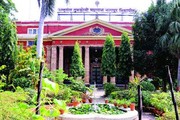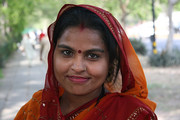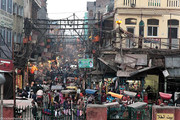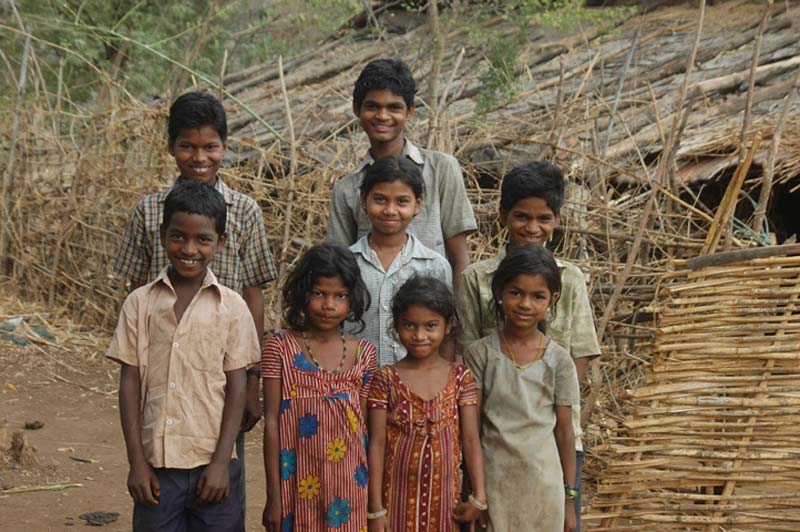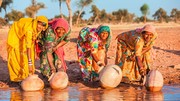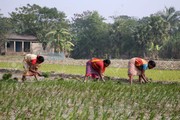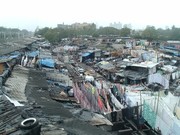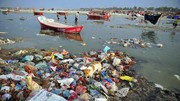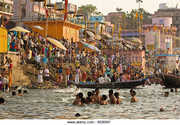Indian culture brought to life in Maywood classroom
When Del and Beverly VanDerWerff made their first trip to India in 1996, they never imagined that they would return there again; yet return they did, and not just once, not twice, but four more times over the next 15 years. Now, when looking back, they can see that it was inevitable. “We fell in love with the country, but even more, we fell in love with the Indian people,” said Del VanDerWerff.
The VanDerWerff’s first traveled to Nagpur, located in the middle of India, where Del worked at the University of Nagpur. He was part of a teachers’ exchange program sponsored by The Nebraska College of Technical Agriculture in Curtis. Del lectured on agricultural practices in the U.S such as land use, crop rotations, application of herbicides/pesticides, etc. During their next four trips in 2000, 2005, 2007, and 2012, the VanDerWerffs lived and worked in New Deli, located in Northern India. Their travels were sponsored by Rotary International in collaboration with North Platte’s Sunrise Rotary Club and the Curtis Rotary.
Del and Beverly wore several hats while in New Deli: they worked in orphanages, and Del taught English and coached basketball; however, their primary goal was to establish an all-girl elementary school. So with the guidance of the Rotary International of India, they started the school in 2000 with 300 elementary age students; now there are close to 1,000 enrolled. Also the school has since expanded the ages to include high school with graduation. The VanDerWerffs have seen firsthand that “young Indian girls don’t have the number of options available to them that girls here in America have. We saw a real need there and we know that education is so important to provide those options,” Del stated.
Another school they visited had only a dirt floor. The VanDerwerffs, coordinating with the Indian Rotary, donated writing tablets to this school. This illustrates the extreme poverty that exists within India, especially in its rural areas. “Many parents are so poor, that they rent out their children to work to add to the parents’ income,” stated Del. In some of the more dire situations, the parents may even sell their children in order to survive.
VanDerwerff explained that when India gained independence from Britain in 1947, the government confiscated all the land and distributed the land to all Indians. So for the first time, rural peasants became landowners. However, that didn’t last long because the farmers were still so poor, they sold their land back to wealthier Indians. Del went on to say that “although the country is still very poor, and little has changed there in last century, the people are genuinely happy. “Everywhere you go, people are smiling and truly happy. Their happiness and sense of wellbeing is clearly not tied to accumulating personal possessions.”
Del said he didn’t want to give the impression that the entire country of India is poor. “Yes, the countryside is very poor, but there is also great wealth found in the cities. For instance, the shopping malls in New Deli would rival any mall in America, including The Mall of America in Minnesota, and the cities also have beautiful modern roads,” stated Del.
While sharing his travels and cultural experiences with Maywood students, Del also had on display many items he brought back from India including coins, jewelry, and clothing. The Maywood girls enjoyed trying on Indian bracelets and especially a sari which is a female garment that consists of a drape made from 7 yards of material. The sari is typically wrapped around the waist, with one end draped over the shoulder. Another interesting aspect of Indian fashion influenced by their culture is the dark red dot worn on the center of the forehead by women. It usually means that a woman is married. However, in recent times, young single women wear the dot as a form of dressing up before going out – as part of their fashion accessories like jewelry or sunglasses.
One adjustment the Vanderwerffs had to make was adapting to Indian food. A staple of Indian cuisine is curry – a seasoned, spicy rice that usually includes fresh or dried hot chilies. “When I first ate curry, it was hotter than anything I had ever experienced – more so than the hottest Mexican dishes,” stated Del. In addition, when you go to wash it down with a cold drink, it must be bottled because “drinking the local water would make you seriously ill. Even the locals drink everything from bottles,” said Del. An interesting note is that 90% of Indians are Hindus, and therefore, they do not eat beef. In fact the cow is sacred to Hindus, and Indians use water buffalos for milk, when the buffalos are not harnessed to a farm plow.
A major reason for lack of clean water is that India’s main source of water - the Ganges River – is rated as the fifth most polluted river in the world. The Ganges suffers from extreme pollution levels, which affect the 500 million people who live close to the river. Sewage from many cities along the river's course, industrial waste and religious offerings wrapped in non-degradable plastics add large amounts of pollutants to the river as it flows through densely populated areas. The problem is exacerbated by the fact that many poorer people rely on the river on a daily basis for bathing, washing, and cooking.
In addition, the Ganges is sacred to the Hindus, and many religious customs are performed on its banks. For example, Hindus usually cremate their deceased (if the family can afford to) and after the cremation, the bones and ashes are thrown into the river. However, in the past, thousands of un-cremated bodies were thrown into the Ganges during cholera epidemics, spreading the disease.
Even today, holy men, pregnant women, people with leprosy/chicken pox, people who have been bitten by snakes, people who have committed suicide, the poor and children under 5 are not cremated, but are floated down the river, free to decompose in its waters. Further, those who cannot afford the large amount of wood needed to incinerate the entire body, leave behind a lot of half burned body parts. The continuing customs of burning dead bodies, throwing carcasses into the river, in addition to open public latrines on its banks, and allowing cattle to wallow freely all contribute to the Ganges dangerous levels of toxic pollution.
The following are a few eye-opening facts about population differences between India and the United States:
INDIA
- The population of India is approaching 1.5 billion.
- By 2020 its population will reach a staggering 2 billion.
- India's population is nearly 20% of the total world population, which is 7.5 billion.
- The population density in India is approx. 1,200 people per mi2. The total land area is about 1 million sq. miles
- 30% Urban - 70% Rural
UNITED STATES
The population of the United States is roughly 325 million, or about 4% of the total world population.
- The population density in the United States is about 100 people per mi2.
- The total land area is roughly 3.5 million sq. miles
- 80% Urban - 20% Rural
Del and Beverly VanDerWerff are planning another trip to India in the near future. Maywood Public School appreciates the VanDerWerff’s invaluable contributions to our school. MPS students look forward to learning about far away people and cultures from them again after their further adventures in India. Look for a follow-up special feature on “The Sights and Sounds of India.”









